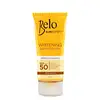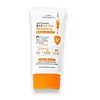What's inside
What's inside
 Key Ingredients
Key Ingredients

 Benefits
Benefits

 Concerns
Concerns

 Ingredients Side-by-side
Ingredients Side-by-side

Water
Skin ConditioningEthylhexyl Methoxycinnamate
UV AbsorberCyclotetrasiloxane
EmollientCyclopentasiloxane
EmollientNiacinamide
SmoothingCetyl Alcohol
EmollientGlyceryl Stearate
EmollientCeteareth-20
CleansingCeteareth-12
EmulsifyingCetearyl Alcohol
EmollientCetyl Palmitate
EmollientButyl Methoxydibenzoylmethane
UV AbsorberButyrospermum Parkii Butter
Skin ConditioningOctocrylene
UV AbsorberBenzyl Alcohol
PerfumingGlyceryl Caprylate
EmollientGlyceryl Undecylenate
EmollientC12-15 Alkyl Benzoate
AntimicrobialHydrogenated Dimer Dilinoleyl/Dimethylcarbonate Copolymer
Emulsion StabilisingTitanium Dioxide
Cosmetic ColorantAlumina
AbrasiveSimethicone
EmollientButylene Glycol
HumectantBee Venom
AstringentSorbitan Palmitate
EmulsifyingSorbitan Olivate
EmulsifyingCarbomer
Emulsion StabilisingTriethanolamine
BufferingBisabolol
MaskingPanthenol
Skin ConditioningTocopheryl Acetate
AntioxidantTetrasodium EDTA
Benzylidene Dimethoxydimethylindanone
Skin ProtectingCitric Acid
BufferingWater, Ethylhexyl Methoxycinnamate, Cyclotetrasiloxane, Cyclopentasiloxane, Niacinamide, Cetyl Alcohol, Glyceryl Stearate, Ceteareth-20, Ceteareth-12, Cetearyl Alcohol, Cetyl Palmitate, Butyl Methoxydibenzoylmethane, Butyrospermum Parkii Butter, Octocrylene, Benzyl Alcohol, Glyceryl Caprylate, Glyceryl Undecylenate, C12-15 Alkyl Benzoate, Hydrogenated Dimer Dilinoleyl/Dimethylcarbonate Copolymer, Titanium Dioxide, Alumina, Simethicone, Butylene Glycol, Bee Venom, Sorbitan Palmitate, Sorbitan Olivate, Carbomer, Triethanolamine, Bisabolol, Panthenol, Tocopheryl Acetate, Tetrasodium EDTA, Benzylidene Dimethoxydimethylindanone, Citric Acid
Water
Skin ConditioningCyclopentasiloxane
EmollientZinc Oxide
Cosmetic ColorantButyloctyl Salicylate
Skin ConditioningDimethicone
EmollientC12-15 Alkyl Benzoate
AntimicrobialGlycerin
HumectantTitanium Dioxide
Cosmetic ColorantCetyl PEG/PPG-10/1 Dimethicone
EmulsifyingPEG-10 Dimethicone
Skin ConditioningDipropylene Glycol
HumectantNiacinamide
SmoothingPolymethyl Methacrylate
Cyclomethicone
EmollientHydrogenated Polydecene
EmollientSilica
AbrasiveHydrogen Dimethicone
Sodium Chloride
MaskingAluminum Hydroxide
EmollientPolyhydroxystearic Acid
EmulsifyingStearic Acid
CleansingSorbitan Olivate
EmulsifyingDisteardimonium Hectorite
StabilisingDimethicone/Vinyl Dimethicone Crosspolymer
Skin ConditioningSorbitan Sesquioleate
EmulsifyingPolyepsilon-Lysine
Skin ConditioningAdenosine
Skin ConditioningPolysilicone-11
Bisabolol
MaskingQuartz
AbrasiveCamellia Japonica Seed Oil
EmollientButylene Glycol
HumectantCentella Asiatica Extract
Cleansing1,2-Hexanediol
Skin ConditioningAsiaticoside
AntioxidantAsiatic Acid
Skin ConditioningMadecassic Acid
Skin ConditioningMadecassoside
AntioxidantWater, Cyclopentasiloxane, Zinc Oxide, Butyloctyl Salicylate, Dimethicone, C12-15 Alkyl Benzoate, Glycerin, Titanium Dioxide, Cetyl PEG/PPG-10/1 Dimethicone, PEG-10 Dimethicone, Dipropylene Glycol, Niacinamide, Polymethyl Methacrylate, Cyclomethicone, Hydrogenated Polydecene, Silica, Hydrogen Dimethicone, Sodium Chloride, Aluminum Hydroxide, Polyhydroxystearic Acid, Stearic Acid, Sorbitan Olivate, Disteardimonium Hectorite, Dimethicone/Vinyl Dimethicone Crosspolymer, Sorbitan Sesquioleate, Polyepsilon-Lysine, Adenosine, Polysilicone-11, Bisabolol, Quartz, Camellia Japonica Seed Oil, Butylene Glycol, Centella Asiatica Extract, 1,2-Hexanediol, Asiaticoside, Asiatic Acid, Madecassic Acid, Madecassoside
 Reviews
Reviews

Ingredients Explained
These ingredients are found in both products.
Ingredients higher up in an ingredient list are typically present in a larger amount.
Bisabolol is famous for its skin soothing properties. It does this by blocking inflammatory signals, helping to reduce your body's reaction to irritation.
This ingredient also interferes with the process of hyperpigmentation. This can help with reducing dark spots and uneven tone.
Bisabolol is an antioxidant. Antioxidants help fight free-radicals. Free-radicals are molecules that may damage your skin cells. By fighting these free-radicals, Bisabolol may slow down signs of aging.
Studies have shown Bisabolol to have antimicrobial properties and may be a fungicide. These properties help preserve a product's shelf life.
All these properties makes bisabolol a great skin barrier helper ingredient.
Bisabolol also helps the absorption of other ingredients.
Note: Synthetic Bisabolol has been shown to be less effective.
Learn more about BisabololButylene Glycol (or BG) is used within cosmetic products for a few different reasons:
Overall, Butylene Glycol is a safe and well-rounded ingredient that works well with other ingredients.
Though this ingredient works well with most skin types, some people with sensitive skin may experience a reaction such as allergic rashes, closed comedones, or itchiness.
Learn more about Butylene GlycolC12-15 Alkyl Benzoate is made up of Benzoic Acid and long chain alcohols. It has a low molecular weight.
C12-15 Alkyl Benzoate is an emollient and texture enhancer. Due to its solubility, it is often used in sunscreens to help evenly distribute active ingredients.
As an emollient, C12-15 Alkyl Benzoate helps soften and hydrate your skin. Emollients create a film on your skin that traps moisture within.
This ingredient has been reported to cause eye irritation.
Learn more about C12-15 Alkyl BenzoateCyclopentasiloxane, or D5, is a silicone used to improve texture of products and trap moisture.
D5 is considered lightweight and volatile. Volatile means it evaporates quickly after application. Once evaporated, D5 leaves a thin barrier that helps keep skin hydrated.
It is also an emollient. Emollients help soften the skin and prevent water loss. Silicones create a silky texture in products. D5 helps other ingredients become more spreadable.
Studies show D5 is safe to use in skincare products. We recommend speaking with a skincare professional if you have concerns.
Learn more about CyclopentasiloxaneNiacinamide is a multitasking form of vitamin B3 that strengthens the skin barrier, reduces pores and dark spots, regulates oil, and improves signs of aging.
And the best part? It's gentle and well-tolerated by most skin types, including sensitive and reactive skin.
You might have heard of "niacin flush", or the reddening of skin that causes itchiness. Niacinamide has not been found to cause this.
In very rare cases, some individuals may not be able to tolerate niacinamide at all or experience an allergic reaction to it.
If you are experiencing flaking, irritation, and dryness with this ingredient, be sure to double check all your products as this ingredient can be found in all categories of skincare.
When incorporating niacinamide into your routine, look out for concentration amounts. Typically, 5% niacinamide provides benefits such as fading dark spots. However, if you have sensitive skin, it is better to begin with a smaller concentration.
When you apply niacinamide to your skin, your body converts it into nicotinamide adenine dinucleotide (NAD). NAD is an essential coenzyme that is already found in your cells as "fuel" and powers countless biological processes.
In your skin, NAD helps repair cell damage, produce new healthy cells, support collagen production, strengthen the skin barrier, and fight environmental stressors (like UV and pollution).
Our natural NAD levels start to decline with age, leading to slower skin repair, visible aging, and a weaker skin barrier. By providing your skin niacinamide, you're recharging your skin's NAD levels. This leads to stronger, healthier, and younger looking skin.
Another name for vitamin B3 is nicotinamide. This vitamin is water-soluble and our bodies don't store it. We obtain Vitamin B3 from either food or skincare. Meat, fish, wheat, yeast, and leafy greens contain vitamin B3.
The type of niacinamide used in skincare is synthetically created.
Learn more about NiacinamideSorbitan Olivate is created from the fatty acids in olive oil and sorbitol.
This ingredient is an oil in water emulsifier. It helps stabilize a product by preventing oils and waters from separating. Sorbitan Olivate also helps hydrate the skin.
Manufacturers sell sorbitan olivate under the name OliveM 1000. OliveM 1000 a multifunctional ingredient. It is self-emulsifying. According to a manufacturer, OliveM 1000 does not disrupt natural skin biome.
Due to its olive oil base, this ingredient may not be fungal-acne safe.
Learn more about Sorbitan OlivateTitanium dioxide is a mineral UV filter widely used in sunscreens and cosmetics.
It is one of only two UV filters officially classified as “mineral” by regulatory agencies, the other being zinc oxide.
Titanium dioxide provides broad-spectrum protection mostly in the UVB and UVAII range, with some protection in the UVAI range.
While its UVA protection isn’t as strong as zinc oxide’s, the difference is minor.
A common myth is that mineral UV filters reflect UV light. However, modern research shows titanium dioxide absorbs UV radiation like chemical filters (~95% absorption & 5% reflection).
Thanks to its non-irritating nature, titanium dioxide is suitable for sensitive, acne-prone, or redness-prone skin. It is unlikely to cause "eye sting" like other sunscreen ingredients.
A major drawback of this ingredient is its white cast and thick texture. This is why mineral sunscreens often leave a white cast and are less cosmetically elegant than chemical/hybrid sunscreens.
To improve white cast and spreadability, micronized or nano-sized titanium dioxide is often used.
There are ongoing concerns surrounding nano-titanium oxide's impact on marine ecosystems.
There is no conclusive evidence that any form of titanium oxide (or any other sunscreen ingredients) will cause harm to marine ecosystems or coral reefs. The science is still developing but many consumers are keeping a close eye on this issue.
Please note, many destinations have reef-safety sunscreen rules. For instance, the U.S. Virgin Islands advises all visitors to use non-nano mineral sunscreens.
Nano mineral sunscreens once raised safety concerns about absorption into skin.
Extensive research has shown that they do not penetrate healthy or damaged skin; they remain safely on the surface and the top layer of dead skin (stratum corneum).
You'll likely find titanium dioxide bundled with alumina, silica, or dimethicone. These ingredients help make titanium dioxide highly photostable; this prevents it from interacting with other formula components under UV light.
Learn more about Titanium DioxideWater. It's the most common cosmetic ingredient of all. You'll usually see it at the top of ingredient lists, meaning that it makes up the largest part of the product.
So why is it so popular? Water most often acts as a solvent - this means that it helps dissolve other ingredients into the formulation.
You'll also recognize water as that liquid we all need to stay alive. If you see this, drink a glass of water. Stay hydrated!
Learn more about Water